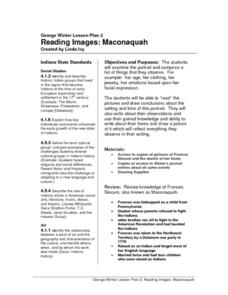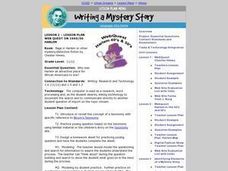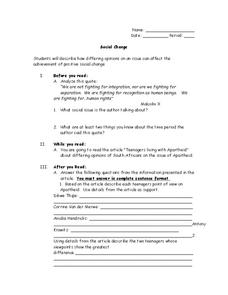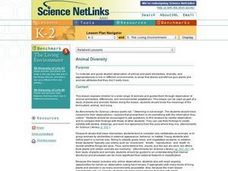Curated OER
Everybody Needs
Students compare cultures. In this needs and wants lesson, students discuss the basic necessities of life and what they need in a day in order to survive. Students also discuss how these needs might change if they lived in another...
Curated OER
Organization: Look at What I Organized!
Students explore organization by participating in an object sorting activity. In this indexing lesson, students examine their classroom and identify materials that should be organized in order to make the room more efficient. Students...
Curated OER
Eye Spy a Pattern
Fifth graders identify patterns by understanding how things work together.
Curated OER
Biotic vs. Abiotic Factors
Learners share their prior knowledge of the elements of the environment. In groups, they are introduced to the concepts of biotic and abiotic factors in a specific environment. They discover their effects on organisms living in the...
Curated OER
Stitching Our Way Through Time to Learn About Nebraska Animals
Students study about animals that have lived in Nebraska in the past, and animals that currently live in Nebraska. They examine how animal life changed since the early beginnings and what has caused these changes?
Curated OER
Literature Circles
Students complete the reading of an age appropriate piece of literature. They think critically about their reading and discuss it with a group of peers. Students make connections among their reading, their own lives, and the discussions...
Curated OER
Frog Raps
Students analyze the different charateristics of frogs and toads. Students analyze how frogs/toads live, what they look like, where they live, their stages of life and how they compare to each other. Students create in small groups...
Curated OER
Technology Shrinks the World
Students examine the impact of inventions. In this technological advancements instructional activity, students compare the technology of the past to the technology of today. They identify inventions that were not available to their...
Curated OER
Understanding Inuit Quajimajatuqangit (IQ)
Pupils research the six principles that support IQ. In this IQ lesson plan, students work in small groups to create a skit that depicts how one's IQ relates to everyday life.
Curated OER
Inuit Culture: The Family
Students examine the attributes of Inuit families. In this cultural practices instructional activity, students read "Saqiyuq: Stories for the Lives of Three Inuit Women," and respond to 10 comprehension and critical thinking questions...
Curated OER
Create a Travel Brochure
Young scholars determine how geography affects how people live, work and play. They identify the different landforms in the three regions of Peru and create a travel brochure highlighting Peru's attractions.
Curated OER
Using Southeast Asian Folktales to Teach Reading and Writing
Young scholars use maps to locate the countries of Thailand, Vietnam and Cambodia. In groups, they compare and contrast the three countries in regard to their culture, morals and values. They read various examples of folktales and write...
Curated OER
Water Pollution, Stream Ecosystems
Students participate in a series of simulated activities designed to demonstrate the interconnectedness between the environment and the organisms that live there. They explore how polluting one element of an environment affects the...
Curated OER
Heat Misconceptions
Third graders determine that gloves do not provide heat, but rather, they insulate or hold in any heat that is in their hand. They discuss the different temperatures found in ecosystems around the world. What do animals that live in...
Curated OER
Reading Images: Maconaquah
Students examine a portrait of Maconaquah and compose a list of things they observe about her. They look at her age, clothing, jewelry, and her emotions based on her facial expression. Conclusions are drawn as they "read" the pictures...
Curated OER
Organisms and Their Environment
Students explore Earth's biosphere. In this biosphere lesson plan, students participate in group activities regarding biotic and abiotic factors, population density, and species' habitats.
Curated OER
Is Climate Change Good for Frogs?
Learners fill out a chart on how climate change would affect them and things around them. In this climate change lesson plan, students discuss how global warming affects them and amphibians and then fill out the chart that goes with it.
Curated OER
WebQuest on 1940/1950 Harlem
Students perform a WebQuest to fin out why Harlem was an attractive place for African Americans to live. Small groups perform the research together, and report to the class.
Curated OER
Ant City
Students develop an ant colony that adults and children can visit. Students create different areas including places where tourists can view live ants, play ant games, research facts about ants, and create ant art. Students serve as...
Curated OER
People of the Plains- Spiritualism
Fourth graders study cultural characteristics regarding Native American beliefs. They discuss spiritualism as it relates to respect. (respect for all things, living and dead; connection with the land, etc.) They provide examples they...
Curated OER
Ray Frank on Gratitude and Repentance
Students explore Ray Frank's biography and achievements in relation to expressing gratitude and repentance. They create a list of the things they are grateful for and what repentance means to them. After listening to a Talmudic story,...
Curated OER
Bible: Introduction Lesson on I Corinthians 12:12-27
Students discuss a Biblical passage and how to apply it to their lives. For this Biblical community lesson, students read I Corinthians 12:12-27 to discover that all people and churches are parts of the body of Christ, and work...
Curated OER
Social Change
In this apartheid worksheet, students read a 1-page selection about teenagers who have lived with apartheid and then respond to 6 short answer questions.
Curated OER
Animal Diversity
Students use the Animal Diversity E-Sheet to access the Where Can Animals Live? online book.

























